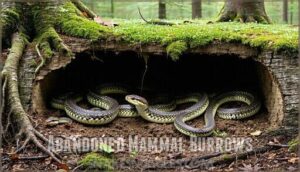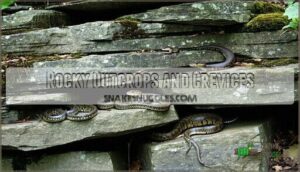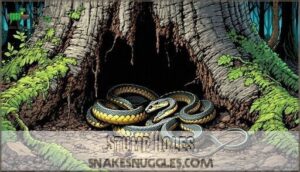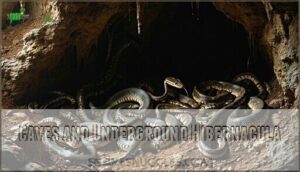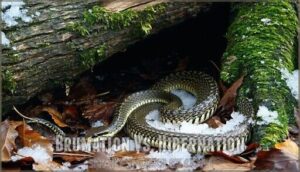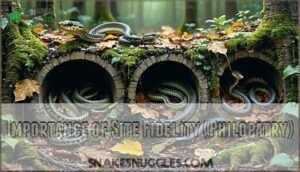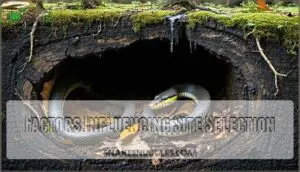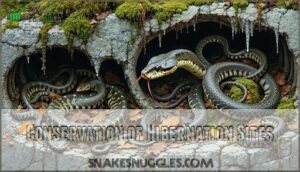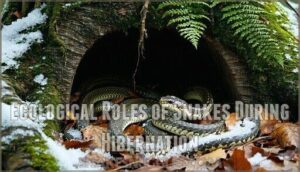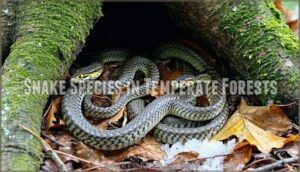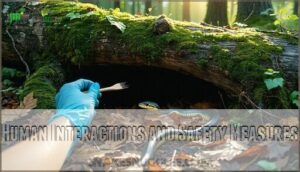This site is supported by our readers. We may earn a commission, at no cost to you, if you purchase through links.
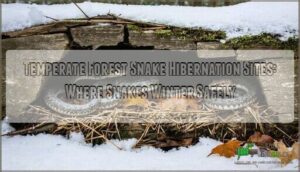
They’re picky about real estate, choosing abandoned rodent burrows, rocky crevices between boulders, hollow tree stumps, and underground caves.
Think of it like snakes playing hide-and-seek with winter, except the stakes are life or death.
These sites must stay above freezing while offering protection from hungry predators and harsh weather.
The secret lies in understanding what makes these locations so irresistible to our scaly neighbors, and how they enter a state of brumation, a sluggish state where they barely move or eat, to survive the winter.
Table Of Contents
- Key Takeaways
- Types of Snake Hibernation Sites
- Hibernation Behaviors of Temperate Forest Snakes
- Factors Influencing Site Selection
- Conservation of Hibernation Sites
- Ecological Roles of Snakes During Hibernation
- Snake Species in Temperate Forests
- Human Interactions and Safety Measures
- Frequently Asked Questions (FAQs)
- How do snakes survive in the temperate forest?
- Where do snakes hide in the forest?
- Where do snakes hide when it’s cold?
- Where do snakes usually hibernate?
- How to find a snake hibernaculum?
- What is the dormant state for snakes?
- Are there snakes in temperate forests?
- What are the common materials used to construct snake hibernacula?
- How do snakes regulate their body temperature during hibernation?
- Do snakes ever emerge from their hibernacula during winter?
- Conclusion
Key Takeaways
- You’ll find snakes in temperate forests surviving winter by brumating in underground sites like abandoned burrows, rocky crevices, stump holes, and caves that stay above freezing.
- Snakes are picky about hibernation spots, choosing locations that offer stable temperatures, protection from predators, and good soil and moisture conditions.
- Many snakes return to the same hibernation sites year after year, so protecting these spots is crucial for their survival and the health of forest ecosystems.
- By understanding and respecting snake hibernacula, you help maintain natural rodent control and support biodiversity in temperate forests.
Types of Snake Hibernation Sites
When winter arrives, you’ll find snakes tucked away in some pretty clever hiding spots that keep them safe from freezing temperatures.
These cold-blooded creatures become masters at finding cozy underground retreats like old groundhog burrows, rocky cracks, rotting tree stumps, and deep caves that stay warm enough to survive the cold months.
Snakes transform into underground survival experts, tucking into nature’s perfect winter hideaways.
Abandoned Mammal Burrows
When you’re exploring temperate forests, abandoned mammal burrows become nature’s perfect snake hibernation hotels.
These underground hibernacula sites offer stable burrow microclimate conditions that keep snakes cozy all winter.
Species dependence varies – some snakes make burrow modifications while others use them as-is.
However, burrow availability creates burrow competition among different species.
These snake dens in abandoned mammal burrows provide essential snake hibernation refuges, protecting our scaly neighbors from harsh temperate forest winters below the frost line.
Understanding the importance of hibernacula for snakes is vital for their survival.
Rocky Outcrops and Crevices
Beyond burrows, rocky outcrops offer snakes premium real estate for reptile dormancy. These natural fortresses create perfect crevice microclimates where temperate forest snakes gather in communal dens. Think of rocks as nature’s thermostat—rockpile insulation keeps temperatures stable while outcrop orientation blocks harsh winds.
Here’s what makes rocky hibernacula sites so appealing:
- Deep crevices protect from freezing temperatures below the frost line
- Stable microclimates maintain 4-6°C throughout winter months
- Multiple entry points allow easy access for various snake species
- Enhanced biodiversity supports crevice biodiversity with shared warming benefits
Stump Holes
Stump holes create cozy snake hibernation sites in temperate forests.
These tree remnants offer perfect reptile dormancy spots when decay stage provides ideal insulation properties.
Key stump hole features snakes love:
- Proper stump hole depth – deeper cavities maintain stable temperatures below frost line
- Microclimate variation – rotting wood creates warmer pockets than surrounding soil
- Species preferences – different snakes favor various decay stages based on size needs
Think of stump holes as nature’s underground apartments – snakes return annually to their favorite spots, showing remarkable site loyalty for winter survival.
Caves and Underground Hibernacula
If you thought stump holes were snug, wait till you peek inside caves and underground hibernacula.
These hidden gems work like winter lodges for snakes, with stable cave microclimates beneath the frost line.
Talk about crowded—communal dens can pack snakes in by the hundreds, whether burrow excavations or even man-made caves, these underground burrows are the backbone of safe snake hibernation.
The snakes use these underground snake hibernacula to survive the winter.
Hibernation Behaviors of Temperate Forest Snakes
When winter arrives, temperate forest snakes don’t truly hibernate like bears do—they enter a state called brumation that’s more like hitting the snooze button on life.
You’ll find these clever reptiles showing remarkable loyalty to their winter hideouts, often returning to the same cozy den year after year like they’ve got a favorite vacation rental.
Brumation Vs. Hibernation
Unlike mammals that truly hibernate, snakes enter brumation—a lighter form of reptile dormancy.
This process shows key metabolic differences: snakes can wake on warm days, need water periodically, and respond to triggering factors like temperature changes.
- Activity Levels: Snakes remain somewhat alert during brumation
- Water Needs: They must drink occasionally, unlike hibernating mammals
- Metabolic Differences: Energy use drops but doesn’t shut down completely
- Triggering Factors: Warm spells can activate snake hibernation behavior temporarily
Importance of Site Fidelity (Philopatry)
Snakes don’t just randomly pick winter hideouts—they’re creatures of habit.
Site fidelity means temperate forest snakes return to the same snake hibernacula year after year, like visiting grandma’s house for holidays.
This philopatry creates evolutionary advantage through den reuse, boosting population stability and genetic diversity.
Understanding a snake’s body temperature regulation is essential for predicting hibernacula choices.
Smart conservation implications: protect these hibernation sites, and you’ll safeguard entire snake communities, which is a key aspect of population stability and maintaining genetic diversity.
Save a hibernaculum, save an entire snake neighborhood—winter homes matter more than you think.
Factors Influencing Site Selection
When you’re a snake looking for the perfect winter hideout, you can’t just pick any old spot—it’s got to check all the right boxes to keep you alive until spring.
Your survival depends on finding a location that offers the right temperature, protection from hungry predators, proper soil conditions, and easy access to food when warmer weather returns, which is crucial for your overall well-being.
Environmental Conditions
Temperature stability ranks as the top priority when snakes shop for winter digs.
These cold-blooded creatures need hibernation sites that maintain steady warmth above the frost line—typically 4-6°C underground.
Humidity levels and soil composition also matter big time for surviving winter’s grip.
Environmental conditions make or break snake hibernacula success:
- Underground burrows that stay cozy while surface temperatures plummet
- Rocky crevices offering natural insulation from temperature swings
- Well-drained spots preventing deadly flooding during spring thaws
Microclimate variation determines whether temperate forest snakes wake up healthy come springtime.
Safety From Predators
Beyond proper temperature control, you’ll find that snakes choose hibernation sites based on predator avoidance strategies.
Group hibernation becomes their safety net—dozens of snakes bundling together in deep burrows or rock crevices where predators can’t reach.
This shelter security reduces vulnerability factors dramatically.
In temperate forest snake hibernation, shared hibernation sites act like underground fortresses, protecting dormant snakes from snake predators through strength in numbers and strategic camouflage strategies.
Microhabitat Preferences
Picture choosing a winter retreat—you’d want the perfect conditions for comfort and safety.
Temperate forest snakes share this instinct when selecting hibernacula based on specific microhabitat preferences.
- Soil Composition: Well-drained, loose soil prevents waterlogging and allows easy burrowing access
- Vegetation Cover: Dense plant material provides insulation and camouflage from predators
- Moisture Levels: Balanced humidity prevents dehydration while avoiding excessive dampness
- Temperature Stability: Consistent above-freezing conditions maintain essential metabolic functions throughout winter
Proximity to Food Sources
You’ll want to check prey availability when scouting hibernation sites – it’s like choosing a neighborhood with good takeout options nearby.
Overwintering snakes pick snake dens within their foraging range to guarantee post-brumation feeding success when they emerge hungry in spring.
| Prey Type | Availability Season | Distance from Den |
|---|---|---|
| Small rodents | Year-round | 100-300 meters |
| Bird eggs | Spring/summer | 50-200 meters |
| Insects | Warm months | 25-100 meters |
| Amphibians | Spring/fall | 150-400 meters |
| Young mammals | Summer | 200-500 meters |
Smart snake habitat selection means balancing seasonal diet needs with juvenile survival rates near quality snake dens.
Conservation of Hibernation Sites
You’ll find that protecting snake hibernation sites isn’t just good for snakes—it’s essential for keeping entire forest ecosystems healthy.
When developers destroy ancient rock crevices or fill in old burrows, they’re basically evicting hundreds of snakes who’ve been using the same winter "hotels" for generations.
Protection of Known Hibernacula
Protecting snake dens isn’t just about marking spots on a map—it’s about building a safety net for temperate forest ecosystems.
When you support habitat restoration projects, you’re giving snakes their winter homes back.
Here’s how you can help:
- Champion legal protection for hibernacula through local conservation groups
- Share snake conservation knowledge with neighbors and schools
- Support climate change research that tracks shifting snake habitat needs
These efforts boost metapopulation stability across entire regions, and contribute to the overall goal of conservation.
Legal and Environmental Policies
Legal policies act like protective shields around snake hibernation sites.
The Endangered Species Act makes destroying protected habitats illegal, with fines awaiting violators.
State regulations vary widely – some ban killing snakes entirely, while others require permits.
Conservation funding flows to habitat protection projects, and development regulations demand environmental reviews before construction.
These conservation strategies create safety nets, ensuring snakes find secure winter homes with the help of the Endangered Species Act.
Impact of Habitat Loss
Every bit of habitat loss chips away at the survival odds for temperate forest snakes.
Here’s how it plays out:
- Population Decline—snakes lose safe hibernation sites, shrinking numbers fast.
- Fragmentation Effects—home ranges split, snakes get stranded.
- Prey Scarcity—less habitat means fewer meals.
- Climate Vulnerability—fewer shelters leave snakes exposed.
Conservation urgency grows as snake habitat disappears.
Habitat loss can be especially devastating for snakes with limited genetic diversity.
Ecological Roles of Snakes During Hibernation
When snakes hunker down for winter, they’re still working hard behind the scenes to keep your forest ecosystem running smoothly.
Even while they’re chilling in their underground hideouts, these sleepy serpents continue to shape the delicate balance of life around them, and in doing so, play a crucial role in maintaining the ecosystem’s balance.
Control of Rodent Populations
Think of snakes as nature’s cleanup crew—they’re working overtime to keep your temperate forest ecosystem balanced.
During hibernation season, these scaly heroes have already done their job controlling rodent populations through predator-prey dynamics.
| Snake Benefits | Impact on Forest |
|---|---|
| Rodent population control | Reduces crop damage |
| Disease prevention | Limits pathogen spread |
| Agricultural protection | Natural pest management |
Their hibernation sites protect these essential workers who maintain ecosystem balance year-round, ensuring natural pest management.
Interactions With Other Species
While rodent population control keeps forests healthy, temperate forest snakes create fascinating social networks during winter.
Predator-prey shifts occur as dormant snakes become vulnerable to foxes and hawks near hibernation sites. Hibernation mutualism develops when blind snakes help owls by eating nest parasites.
Dormancy competition intensifies at abandoned mammal burrows, where larger species dominate prime spots, forcing smaller snakes into riskier shelters. Riparian zones offer crucial shelter and hibernation sites for various snake species.
Communal dens can house 70,000 snakes from multiple species together.
- Parasitism effects shift relationships when resources become scarce during winter.
- Ecosystem stability improves through these complex winter partnerships and rivalries.
Effects on Ecosystem Balance
You’ll find that snake hibernation sites serve as nature’s balance keepers in temperate forest ecosystems.
Even while dormant, snakes maintain ecosystem resilience through their strategic winter locations.
Their hibernation sites become command centers for forest ecosystem health:
- Rodent population control – Proximity effects continue even during dormancy
- Predator-prey dynamics – Influence hunting patterns of other species
- Nutrient cycling – Hibernation sites concentrate organic matter decomposition
- Biodiversity impact – Shared hibernacula support multiple species interactions
- Ecosystem balance – Strategic site placement maintains forest food webs year-round
Snake Species in Temperate Forests
You’ll find several snake species calling temperate forests home, each with their own winter survival tricks.
Northern pine snakes, timber rattlesnakes, and garter snakes all share these woodland habitats but choose different spots to wait out the cold months.
Northern Pine Snakes
Among the eastern temperate forests, Northern Pine Snakes stand out as specialized burrowing artists.
These impressive serpents, reaching over six feet long, excel at excavating their own underground hibernacula in sandy soils.
| Habitat Specifics | Pine Snake Brumation | Conservation Status |
|---|---|---|
| Dry upland pine forests | Self-dug burrows preferred | Locally threatened species |
| Sandy, well-drained soils | Strong site fidelity | Habitat loss concerns |
| Eastern United States range | Reuse same hibernation sites | Regional Variations exist |
| Abandoned mammal burrows | Diet During Brumation: none | Collection pressures |
You’ll find these non-venomous constrictors demonstrating remarkable philopatry, returning to identical snake hibernation sites year after year like creatures of habit.
Timber Rattlesnakes
Timber Rattlesnakes make rocky outcrops their winter homes in temperate forests.
You’ll find these hibernacula tucked into talus slopes and crevices with southern exposures.
Their Venom Composition helps control rodents year-round.
Despite Population Threats from habitat loss, their Conservation Status remains stable.
These communal denners return to the same hibernation sites annually, showcasing remarkable site fidelity in their Habitat Range.
Other Common Species
Beyond timber rattlesnakes, you’ll encounter several temperate forest snakes with unique hibernation strategies.
Garter snakes form massive communal dens, while copperhead dens often shelter small groups. Water snakes seek rocky crevices near streams, and rat snakes prefer abandoned burrows.
These snake species showcase remarkable hibernation behavior across temperate forest habitats. Snakes’ scales, made of keratin, serve protective and sensory functions.
- Garter Snakes – Bundle together in huge groups for warmth
- Copperhead Dens – Small family gatherings in rotting logs
- Rat Snakes – Solo artists using old animal burrows
- Milk Snakes – Hide under stumps and stone piles
Human Interactions and Safety Measures
Understanding where snakes hibernate helps you stay safe while exploring winter forests and protecting these important animals.
You’ll learn simple ways to spot potential hibernation sites, avoid unwanted encounters, and appreciate why snakes deserve our respect rather than fear.
Identifying and Avoiding Hibernacula
Nature’s early warning system helps you spot temperate forest snake hibernation sites before trouble starts.
Look for shed skins near rocky outcrops, disturbed soil around burrows, and snake trails leading to hibernacula entrances. Understanding snake species identification can help determine if a snake is venomous or harmless.
Maintain safe distances from these snake habitats during seasonal awareness periods. Teach family education about visual cues like basking areas on south-facing slopes.
When in doubt, seek professional assistance.
Preventing Snake Encounters
You don’t need to stumble upon a snake’s winter hideout to prevent unwanted encounters. Simple Yard Maintenance like clearing brush piles and Seal Entry Points around your home’s foundation work wonders.
These Coexistence Strategies respect snake hibernation sites while keeping everyone safe. Regular upkeep can improve overall property maintenance.
- Remove rock piles and debris where snakes might winter
- Plant Snake-Repellent Plants like marigolds around problem areas
- Call for Professional Removal if you discover active hibernacula
Educating The Public on Benefits
You can help your neighbors understand that snakes aren’t villains but valuable allies in temperate forest ecosystems.
Through public education about ecological roles and snake behavior, you’ll reduce fear and promote coexistence strategies.
Share how snakes provide ecosystem services like controlling rodents, which protects public health.
Understanding snake hibernation products can further educate the public about snake hibernation and ecosystem services.
Teaching others about snake habitats builds conservation advocacy and creates safer communities for everyone.
Frequently Asked Questions (FAQs)
How do snakes survive in the temperate forest?
When winter’s icy grip threatens, you’ll find snakes performing an amazing disappearing act in temperate forests.
They retreat underground into rock crevices, abandoned burrows, and deep dens below the frost line, entering brumation where their metabolism slows dramatically to survive freezing temperatures.
Where do snakes hide in the forest?
You’ll find snakes tucked under logs, inside tree stumps, beneath rock piles, and in abandoned burrows throughout forests.
They also squeeze into caves, hide under fallen leaves, and slip into crevices between rocks for protection.
Where do snakes hide when it’s cold?
Your slithery neighbors aren’t actually plotting world domination—they’re just trying not to become snake popsicles.
When temperatures drop, snakes seek underground burrows, rock crevices, rotting logs, and deep leaf piles below the frost line for winter survival.
Where do snakes usually hibernate?
You’ll find snakes tucked away in underground burrows, rock crevices, caves, and beneath fallen logs during their winter brumation period.
They’re basically nature’s ultimate couch potatoes, seeking cozy spots below the frost line.
How to find a snake hibernaculum?
Like a detective following clues, you’ll spot hibernacula by looking for rock piles, rotting logs, abandoned burrows, and cave openings below the frost line where snakes gather for winter survival.
What is the dormant state for snakes?
Snakes don’t actually hibernate like mammals do. Instead, they enter brumation, a reptile-specific dormant state where their metabolism slows dramatically but they can still wake up on warmer winter days.
Are there snakes in temperate forests?
Yes, you’ll find many snakes in temperate forests!
These woodland areas provide perfect homes for species like garter snakes, rat snakes, and copperheads, who thrive in the mixed habitat of trees, underbrush, and seasonal changes.
What are the common materials used to construct snake hibernacula?
Mother Nature’s underground hotel features rock crevices, abandoned rodent burrows, rotting logs, and deep root systems.
You’ll find snakes choosing spots below the frost line where temperatures stay above freezing, creating cozy winter retreats.
How do snakes regulate their body temperature during hibernation?
During brumation, you can’t actively regulate body temperature like mammals do.
Instead, you’d rely on your hibernaculum‘s stable microclimate, which stays around 4-6°C from soil insulation, preventing freezing while slowing metabolism.
Do snakes ever emerge from their hibernacula during winter?
During warm winter spells, you’ll find snakes occasionally emerging from their dens. They won’t eat but might drink water or bask briefly before retreating back underground.
Conclusion
Like Goldilocks finding the perfect porridge, snakes have mastered the art of choosing just-right temperate forest snake hibernation sites.
You’ve learned how these clever reptiles select abandoned burrows, rocky crevices, and hollow stumps that stay above freezing while offering protection.
Understanding these winter retreats helps you appreciate the delicate balance snakes maintain in forest ecosystems.
By protecting these essential hibernacula, you’re ensuring these fascinating creatures continue their important ecological roles for generations to come.
- https://northernwoodlands.org/outside_story/article/snakes-underground-winter
- https://www.sciencedirect.com/science/article/pii/S2351989423004006
- https://bioone.org/journals/journal-of-herpetology/volume-54/issue-2/18-143/A-Long-Term-Study-on-Massasaugas-Sistrurus-catenatus-Inhabiting-a/10.1670/18-143.full
- https://a-z-animals.com/blog/do-snakes-hibernate-in-florida/
- https://envirobug.com.au/blogs/envirobug-blog/everything-you-need-to-know-about-snake-hibernation

